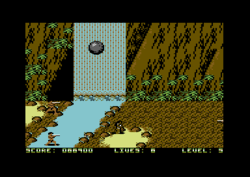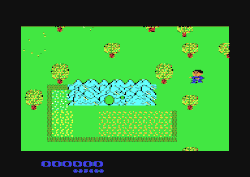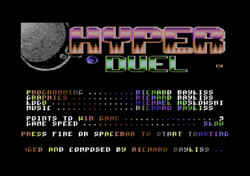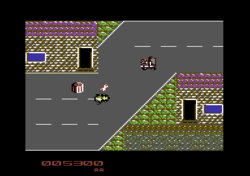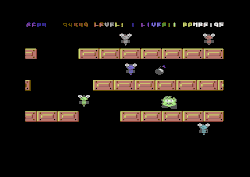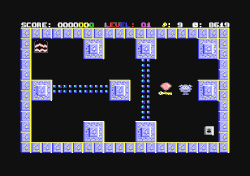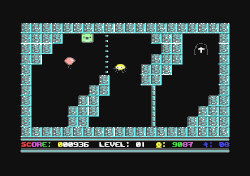Richard Bayliss
Richard Bayliss is a C64 musician and coder of demos and games. He was born on 25.12.1978 and lives in South Birmingham, Great Britain. His curriculum vitae is given later in this page.
Many of his games were created with SEUCK. He founded the group "The New Dimension (TND)" in 2000, at this time as a "one-man group". His homepage has been online since 2001 . He also actively contributes to the diskmag GameOver(view).
The following is a small list of his many works:
Programs (Selection)[edit | edit source]
Games[edit | edit source]
- 2019
- Amazon Tales (1. Version in 2012; 16KB version; 75% final)
- Blastopia DX (RGCD 16KB Compo 2019 edition)
- Let's Invade 2
- Rocket 'N Roll
- Squibblies 3 - Mucus's Revenge
- 2018
- 2017
- Delta Run
- Delta Run RX
- Starfysh
- Star Toast
- Vortex Crystals - 2015/17 (16 KB version)
- 2016
- Blap 'n Bash - Revisited (16 KB version)
- Granny's Teeth
- Let's Invade
- Zap Zone
- 2015
- 2014
- Dark Force
- Dark Force - Redux
- Honey Bee - Redux (RGCD 16KB Compo 2014 edition)
- X-Force - 2015/14
- 2013
- Invert
- Revenge of the Tomato
- Sheepoid Deluxe (16 KB-Version, Psytronik edition)
- 2012
- Trance Sector (Demo) (with 14 game levels)
- Woolly Jumper (aka Sheepoid 2) - 2012/13 (16 KB-version, Psytronik edition)
- Wyvern
- 2011
- 2010
- Bionik Granny Returns
- Mutilator
- Nyaaaah! - 15th Anniversary Edition
- Spittis Search V2
- Toxic (4KB-Version)
- 2009
- Bah, Humbug!
- Bomb Chase 2009 - Special Edition
- Trash Course (other developer: Sledgie)
- 2008
- 2007
- 2006
- 2005
- Balloonacy 2
- Deep Sea Salvage
- For Speed We Need V2
- Grid Zone - Remix (Cronosoft)
- Jeffy
- Protectoid
- Xmas Crazy
- 2004
- 2003
- For Speed We Need
- Froggy Goes Splatt!
- Gift Craze
- Gravity 3
- Missile Blasta
- Nyaaaah!
- Sharkz II V1.2
- Shgut Down
- Super Galaxys Duel
- Super Seven
- Switch It!
- Wash Out
- 2002
- Bomb Chase
- Capture 2
- Cherry Dash
- Galaxys
- Ouch! 2
- Poing
- Psycho (TND)
- Pudding Breath
- Star Blazers
- Super Pac Twins
- 2001
- 2000
- Blast Fast
- Defuzion 2
- Drop Down
- Fluff
- Gravity
- Gravity 2
- Heavy Metal Solid (Preview)
- Magyk
- Ouch!
- Robot
- Stealth 4
- 1999
- Cetimiex
- Freespace 2075
- Hysterix
- Moon Madness
- Target-X - 1999/2000
- Sheepoid- 200?
- 1998 and before
- Sliggy S.O.S - 1998
- Anger - 1991
- Ants at War - 1991
Music[edit | edit source]
- Spittis Search V2 - 2010
- Trash Course - 2009
- Gold Quest 4 - 2008
- Gold Quest 2007 - 2007
- The Vice of Miami - 2006
- That Annoying Ring Tone - 2006
- Gold Quest III - 2006
- Gold Quest II - 2006
- Gold Quest - 2005
- Balloonacy - 2001
- Sub Hunter - 2008
Demos[edit | edit source]
- Dancing Dawg - 2005
- Goldfish Demo - 2004
Tools[edit | edit source]
- Extreme Demo Maker PAL+NTSC - 2005
- SEUCK Buster V1.2 - 2007
His life story[edit | edit source]
My name is Richard, Christopher, Bayliss. My age is 27 years old and I live in South Birmingham, United Kingdom. My occupation is a warehouse assistant at a pharmaceutical distribution company where I have to pick orders and pack them ready for carriage to chemists around the Midlands, London and Northants. I first owned a Commodore 64 when I was 11 or 12 years old, as a Birthday present on Christmas day. I was mainly a games freak then.
I first got into the creative side of the Commodore 64 by using Sensible Software's shoot 'em up construction kit. There was a SEUCK cult in the 1990's. I have to admit. The first ever game I wrote was nothing too special. It was just an experimentation on creating graphics and generally playing around with this tool. What was my first game? It was called "Clip Clop". The game used background from SEUCK's Slap & Tickle, but the sprites were completely daft. The player was a black and orange square and the bullets were white squares. There were mad enemies too, which included barred windows, and other silly sorts.
In 1994 I learned small bits of BASIC programming and started to end up with games, where each object kept rolling, and you had to hit the Spacebar, to see whether or not you get a match of 3 coloured balls in a row. When people pressed space, if there was a match of 3 green balls in a row, the player won points. Else if they failed to match the 3 balls then game was over. It was simple to code, but I found it to be fun. 1994 was also the year I bought a utilities tape from Binary Zone PD, after it was featured in the Commodore Format magazine (Issue 44). This was when I started to play around with different graphics editors, sprite editors and music editors like Future Composer, DMC, USA Music Assembler and other tools.
1995 was the year I started grabbing loads of tools and tool collections from public domain libraries (Well, I had to buy those and they were really cheap. All being charged were disks and copying fee which was about £1.25). The value for money was excellent. Megatronix PD had a massive range of tools disks that I thought I check out and play with. 1995 was also the year I learned hacking - erm, not hacking exactly but ripping IRQ interrupts, etc. It wasn't until 1999 I learned to code IRQ. Anyway back to 1995. The interrupts were ripped, and I used to import music that I created in DMC or any other music composers and import those into my own BASIC game creations.
Those years I still made loads and loads of games using SEUCK. Nyaaaah! was the first ever game I released to the public domain. As an added bonus, when I released this game to Binary Zone PD, music was added to the game. It was a rendition of a tune called "Pianowork", which Brian/Graffity did on the DMC player. Through those years, I was learning to hack my SEUCK creations to try and do something different. The only best thing that I could do was update the colour bars with some more nice raster bar colours. I was very pleased with my result. You'll notice how in SEUCK you can't manage the colour bars of your own SEUCK game, unless you could enter the M/C monitor on the action replay.
1999 was the year I moved on to assembly coding. My first ever assembly coded game was call Cetimiex. The name was obviously non-existant and was plain shit. However, it was my first attempt at coding a game and it had to be bad. The game had loads of bugs in it, which could not have been helped, as I was learning at that time. The main game project in 1999 was Target-X, which took a few weeks to create. Once this game was finished, it turned out to be a good result, despite bugs still there.
It wasn't until 2001 I joined the scene and launched The New Dimension web site brand. I was invited to join a demo group called Civitas as a musician. I agreed. Music was my strongest task in the scene. Programming was my weakest. However, as time moved further, I created more and more fun games for fun, and now my web site seems to be crammed with practically every single game creation I produced.
It is not only games that I created in the scene. I also created stuff like intros to link to my own games. People asked me to stop making those intros for my own games as they look more like cracktros and make file size longer. I used TND intros in the past, to show off my own label. However later games never used the TND cracktro-style intros the games were on their own. As well as intros, I used to create my own demos, and co-op demos. The best demo in my experience so far had to be the demo part I wrote for Civitas' entry for Cosine's Singles demo project. I was impressed with my result. It was something simple to code, looked very nice. Especially with JSL's logo/picture.
As times moved on and on. I created more and more games, but the best game that I created had to be the following titles: Balloonacy (People loved this game), Balloonacy 2, Bomb Chase, Grid Zone Remix (Loads of people like this enhanced version of the original Grid Zone) and Heavy Metal Deluxe.
Friendly regards: Richard Bayliss
